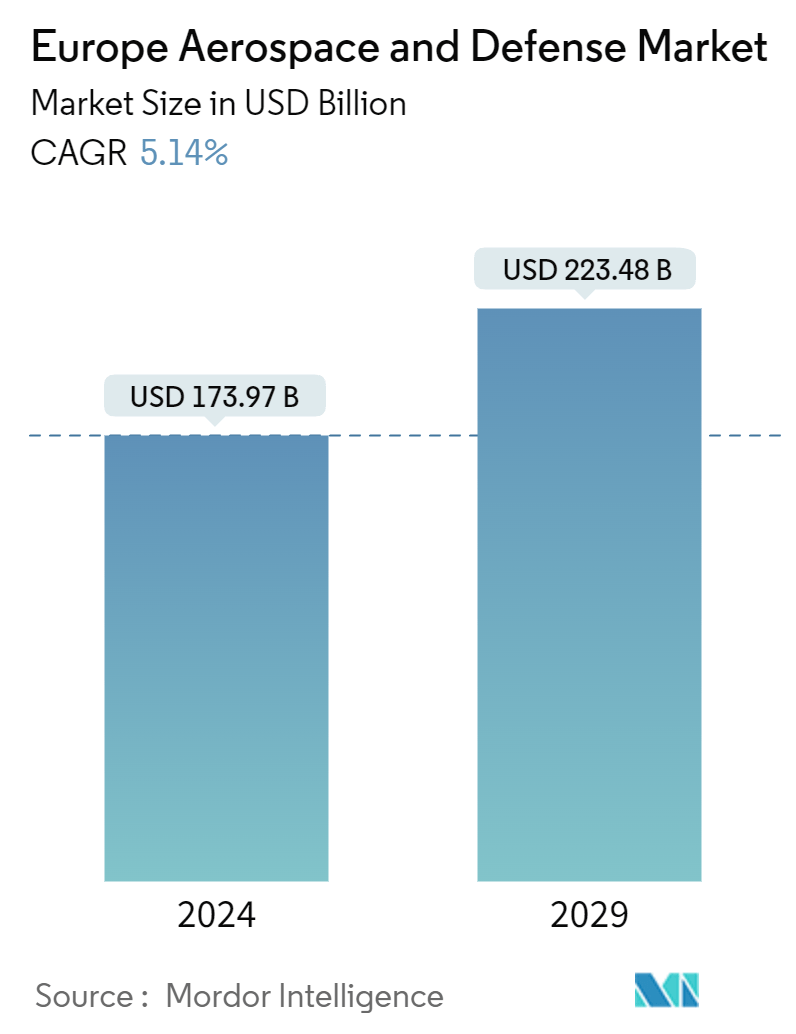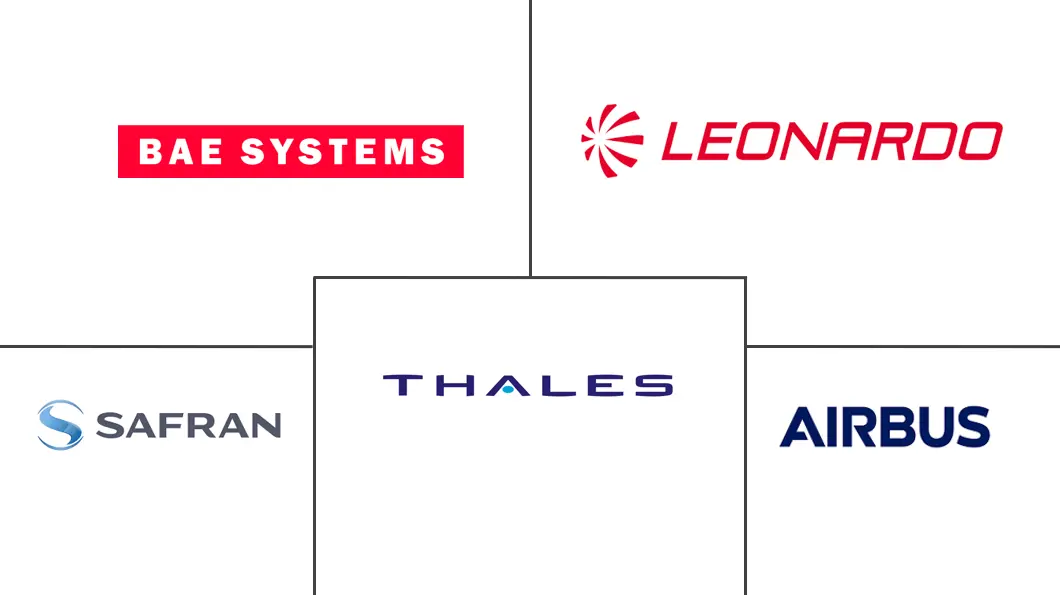Market Size of Europe Aerospace And Defense Industry

| Study Period | 2019 - 2029 |
| Base Year For Estimation | 2023 |
| Market Size (2024) | USD 173.97 Billion |
| Market Size (2029) | USD 223.48 Billion |
| CAGR (2024 - 2029) | 5.14 % |
| Market Concentration | Medium |
Major Players
*Disclaimer: Major Players sorted in no particular order |
Europe Aerospace and Defense Market Analysis
The Europe Aerospace And Defense Market size is estimated at USD 173.97 billion in 2024, and is expected to reach USD 223.48 billion by 2029, growing at a CAGR of 5.14% during the forecast period (2024-2029).
The European market is expected to grow primarily due to the armed forces' procurement and upgradation activities to counter emerging threats. Military forces in European countries use multiple aircraft across their Air Force and naval aircraft. Owing to the increasing international conflicts in Russia, Ukraine, and the Middle East, countries in Europe are gearing up to tackle any potential issues arising from such conflicts. As a result, significant investments in upgrading the existing fleet and purchasing a new fleet equipped with efficient technologies have been witnessed over the past year.
The European aerospace and defense market is undergoing a revolutionary shift driven by rapid advancements in technologies. Cutting-edge innovations in artificial intelligence (AI), advanced materials, 3D printing, and autonomous and unmanned systems are reshaping the industry. Companies like BAE Systems PLC, Dassault Aviation SA, Fincantieri SpA, GKN Aerospace, and Leonardo SpA are at the forefront, investing substantially in research and development to usher in the next generation of aircraft. Incorporating AI and advanced materials enhances the performance of manned platforms and promotes high demand for unmanned systems.
While the aerospace and defense industry stands on the cusp of significant growth, it faces formidable challenges in supply chain vulnerabilities. The industry's supply chains, often global and intricate, are susceptible to disruptions, as evidenced by the impact of the COVID-19 pandemic on production and logistics. Ensuring the resilience of these supply chains is crucial for maintaining consistent operations and meeting the demands of defense programs. Similarly, at least semiconductor ship shortages in the European market will continue till 2024. However, Europe is building its own factories and shifting production away from Taiwan while dealing with changing technology, labor shortages, factory fires, and cyber attacks. Such factors are expected to drive demand in the European market during the forecast period.
Europe Aerospace and Defense Industry Segmentation
The European aerospace and defense market includes the design and manufacture of aircraft, rockets, missiles, and spacecraft that operate in space. Defense equipment refers to weapons, arms, and equipment used for military purposes. The study conducted in this report provides an in-depth analysis of the European aerospace and defense market.
The European aerospace and defense market is segmented by commercial and general aviation, military aircraft and systems, unmanned aerial systems, and space systems and equipment. The report also offers the market sizes and forecasts for five countries across the region. For each segment, the report offers market sizing and forecasts in value (USD) terms.
| Commercial and General Aviation | |||||||||||||||||||||||||||
| Market Overview | |||||||||||||||||||||||||||
| |||||||||||||||||||||||||||
| Market Trends | |||||||||||||||||||||||||||
| |||||||||||||||||||||||||||
|
| Military Aircraft and Systems | |||||||||||||||
| Market Overview | |||||||||||||||
| |||||||||||||||
| |||||||||||||||
| Market Trends | |||||||||||||||
| MRO | |||||||||||||||
| Research and Development | |||||||||||||||
| Training and Flight Simulators | |||||||||||||||
| Competitor Analysis | |||||||||||||||
| Supply Chain Analysis | |||||||||||||||
| Customer/Distributor Information | |||||||||||||||
| |||||||||||||||
|
| Unmanned Aerial Systems | |||||
| Market Overview | |||||
| |||||
| Market Trends | |||||
| Research and Development | |||||
| Competitor Analysis | |||||
| Regulatory Landscape and Future Policy Changes | |||||
|
| Space Systems and Equipment | |||||||||||||
| Market Overview | |||||||||||||
| |||||||||||||
| Market Trends | |||||||||||||
| Research and Development | |||||||||||||
| Competitor Analysis | |||||||||||||
| Regulatory Landscape and Future Policy Changes | |||||||||||||
| Customer Information | |||||||||||||
| Segmentation: Space Launch Vehicle, Spacecraft, and Ground Systems | |||||||||||||
|
| Geography | |
| United Kingdom | |
| France | |
| Germany | |
| Italy | |
| Spain | |
| Rest of Europe |
Europe Aerospace And Defense Market Size Summary
The European aerospace and defense market is poised for significant growth, driven by the need for military procurement and upgrades to address emerging geopolitical threats. The increasing international conflicts, particularly in regions like Russia, Ukraine, and the Middle East, have prompted European countries to invest heavily in modernizing their military fleets. This includes the acquisition of advanced aircraft and technologies to enhance their defense capabilities. The market is also experiencing a technological revolution, with innovations in artificial intelligence, advanced materials, and unmanned systems reshaping the industry landscape. Key players such as BAE Systems, Dassault Aviation, and Leonardo are leading the charge in research and development to introduce next-generation aircraft, which are expected to drive demand in the coming years.
In addition to military advancements, the commercial aerospace sector in Europe is witnessing a robust recovery, with a surge in air passenger traffic post-COVID-19. This has led to increased orders for new commercial aircraft as airlines expand their fleets to accommodate the growing number of travelers. The business aviation segment is also thriving, fueled by the rising number of ultra-high-net-worth individuals seeking private travel options. However, the industry faces challenges such as supply chain vulnerabilities and semiconductor shortages, which are being addressed through strategic investments and local production initiatives. The market's semi-consolidated nature, with major players like Airbus, BAE Systems, and Safran, underscores the competitive landscape, as these companies strive to secure long-term contracts and enhance their market share through continuous technological advancements.
Europe Aerospace And Defense Market Size - Table of Contents
-
1. MARKET SEGMENTATION
-
1.1 Commercial and General Aviation
-
1.1.1 Market Overview
-
1.1.2 Market Dynamics
-
1.1.2.1 Drivers
-
1.1.2.2 Restraints
-
1.1.2.3 Opportunities
-
-
1.1.3 Market Trends
-
1.1.4 Commercial Aircraft
-
1.1.4.1 Air Traffic
-
1.1.4.2 Training and Flight Simulators
-
1.1.4.3 Airport Services (Ground Support Equipment and Logistics)
-
1.1.4.4 Structures
-
1.1.4.4.1 Airframe
-
1.1.4.4.1.1 Materials (Composite, Metal and Metal Alloys, Other Materials)
-
1.1.4.4.1.2 Adhesives and Coatings
-
-
1.1.4.4.2 Engine and Engine Systems
-
1.1.4.4.3 Cabin Interiors
-
1.1.4.4.4 Landing Gear
-
1.1.4.4.5 Avionics and Control Systems
-
1.1.4.4.5.1 Communication System
-
1.1.4.4.5.2 Navigation System
-
1.1.4.4.5.3 Flight Control System
-
1.1.4.4.5.4 Health Monitoring System
-
-
1.1.4.4.6 Electrical Systems
-
1.1.4.4.7 Environmental Control Systems
-
1.1.4.4.8 Fuel and Fuel Systems
-
1.1.4.4.9 MRO
-
1.1.4.4.10 Research and Development
-
1.1.4.4.11 Supply Chain Analysis (Design, Raw Materials, Manufacturing, Assembly, Testing, and Certification)
-
1.1.4.4.12 Competitor Analysis
-
-
-
1.1.5 General Aviation (Includes Business Jets, Helicopter, and Personal Aircraft)
-
1.1.5.1 Air Traffic
-
1.1.5.2 Training and Flight Simulators
-
1.1.5.3 Airport Services (Ground Support Equipment and Logistics)
-
1.1.5.4 Structures
-
1.1.5.4.1 Airframe
-
1.1.5.4.1.1 Materials (Composite, Metal and Metal Alloys, Other Materials)
-
1.1.5.4.1.2 Adhesives and Coatings
-
-
1.1.5.4.2 Engine and Engine Systems
-
1.1.5.4.3 Cabin Interiors
-
1.1.5.4.4 Landing Gear
-
1.1.5.4.5 Avionics and Control Systems
-
1.1.5.4.5.1 Communication System
-
1.1.5.4.5.2 Navigation System
-
1.1.5.4.5.3 Flight Control System
-
1.1.5.4.5.4 Health Monitoring System
-
-
1.1.5.4.6 Electrical Systems
-
1.1.5.4.7 Environmental Control Systems
-
1.1.5.4.8 Fuel and Fuel Systems
-
1.1.5.4.9 MRO
-
1.1.5.4.10 Research and Development
-
1.1.5.4.11 Supply Chain Analysis
-
1.1.5.4.12 Competitor Analysis
-
-
-
-
1.2 Military Aircraft and Systems
-
1.2.1 Market Overview
-
1.2.2 Defense Spending and Budget Allocation Details
-
1.2.2.1 Army
-
1.2.2.2 Navy and Marine Corps
-
1.2.2.3 Air Force
-
-
1.2.3 Market Dynamics
-
1.2.3.1 Drivers
-
1.2.3.2 Restraints
-
1.2.3.3 Opportunities
-
-
1.2.4 Market Trends
-
1.2.5 MRO
-
1.2.6 Research and Development
-
1.2.7 Training and Flight Simulators
-
1.2.8 Competitor Analysis
-
1.2.9 Supply Chain Analysis
-
1.2.10 Customer/Distributor Information
-
1.2.11 Combat Aircraft
-
1.2.11.1 Structures
-
1.2.11.1.1 Airframe
-
1.2.11.1.1.1 Materials (Composite, Metal and Metal Alloys, Other Materials)
-
1.2.11.1.1.2 Adhesives and Coatings
-
-
1.2.11.1.2 Engine and Engine Systems
-
1.2.11.1.3 Landing Gear
-
-
1.2.11.2 Avionics and Control Systems
-
1.2.11.2.1 General Avionics
-
1.2.11.2.2 Mission Specific Avionics
-
-
1.2.11.3 Missiles and Weapons
-
-
1.2.12 Non-combat Aircraft
-
1.2.12.1 Structures
-
1.2.12.1.1 Airframe
-
1.2.12.1.1.1 Materials (Composite, Metal and Metal Alloys, Other Materials)
-
1.2.12.1.1.2 Adhesives and Coatings
-
-
1.2.12.1.2 Engine and Engine Systems
-
1.2.12.1.3 Landing Gear
-
-
1.2.12.2 Avionics and Control Systems
-
1.2.12.2.1 General Avionics
-
1.2.12.2.2 Mission-specific Avionics
-
-
1.2.12.3 Missiles and Weapons
-
-
-
1.3 Unmanned Aerial Systems
-
1.3.1 Market Overview
-
1.3.2 Market Dynamics
-
1.3.2.1 Drivers
-
1.3.2.2 Restraints
-
1.3.2.3 Opportunities
-
-
1.3.3 Market Trends
-
1.3.4 Research and Development
-
1.3.5 Competitor Analysis
-
1.3.6 Regulatory Landscape and Future Policy Changes
-
1.3.7 Segmentation
-
1.3.7.1 Commercial
-
1.3.7.2 Military
-
-
-
1.4 Space Systems and Equipment
-
1.4.1 Market Overview
-
1.4.2 Market Dynamics
-
1.4.2.1 Drivers
-
1.4.2.2 Restraints
-
1.4.2.3 Opportunities
-
-
1.4.3 Market Trends
-
1.4.4 Research and Development
-
1.4.5 Competitor Analysis
-
1.4.6 Regulatory Landscape and Future Policy Changes
-
1.4.7 Customer Information
-
1.4.8 Segmentation: Space Launch Vehicle, Spacecraft, and Ground Systems
-
1.4.9 Segmentation: Satellites
-
1.4.9.1 By Subsystem
-
1.4.9.1.1 Command and Control System
-
1.4.9.1.2 Telemetry, Tracking, Commanding, and Monitoring (TTCM)
-
1.4.9.1.3 Antenna System
-
1.4.9.1.4 Transponders
-
1.4.9.1.5 Power System
-
-
1.4.9.2 By Application
-
1.4.9.2.1 Military
-
1.4.9.2.2 Commercial
-
-
-
-
1.5 Geography
-
1.5.1 United Kingdom
-
1.5.2 France
-
1.5.3 Germany
-
1.5.4 Italy
-
1.5.5 Spain
-
1.5.6 Rest of Europe
-
-
Europe Aerospace And Defense Market Size FAQs
How big is the Europe Aerospace And Defense Market?
The Europe Aerospace And Defense Market size is expected to reach USD 173.97 billion in 2024 and grow at a CAGR of 5.14% to reach USD 223.48 billion by 2029.
What is the current Europe Aerospace And Defense Market size?
In 2024, the Europe Aerospace And Defense Market size is expected to reach USD 173.97 billion.

